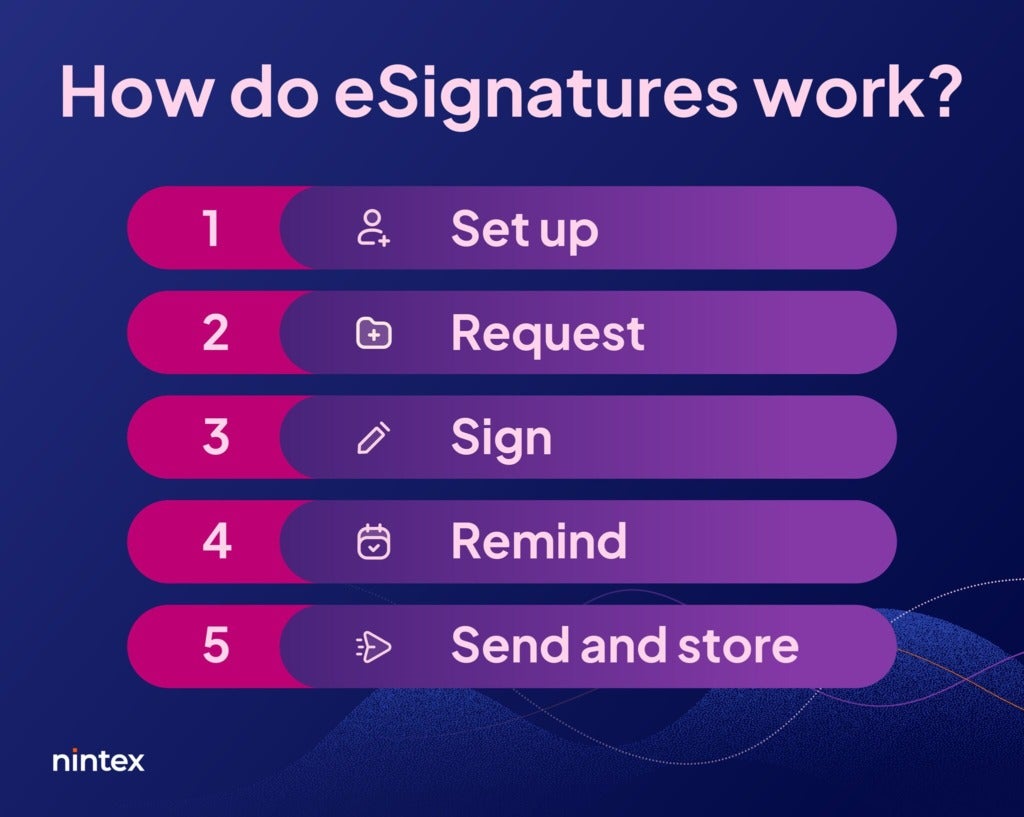It’s been quite a while since a pen and ink were needed to make a business deal official. An electronic signature, or eSignature, is a convenient, cost-effective, legally binding, and secure way for signers to electronically agree to a document’s terms and conditions without needing a “wet” (pen and paper) signature.
Definition of an eSignature
An eSignature, or electronic signature, is a digital method of signing documents that indicates consent or approval. It replaces handwritten signatures and is legally binding in many jurisdictions. eSignatures enhance efficiency by allowing users to sign documents remotely, ensuring secure authentication, tamper-proof records, and streamlined workflows across various devices and platforms.
Why use eSignatures?
Electronic signatures are very common in today’s business world due to their efficiency, simplicity, and environmental friendliness. Many of these transactions are multi-party, making the traditional signing process time-consuming, expensive, and error-prone.
eSignature solutions available on the market today allow you to set up, request, sign/remind, send, and store documents. They also allow you to manage the workflow around the eSignature process itself, including actions that must be taken before and after the actual signing ceremony.
These solutions enable you to do all of this from any device, anywhere. Integrations are also a key component of an eSignature solution. They allow organizations to pull and merge data from CRM systems like Salesforce. You can also integrate eSignatures into existing user workflows that are currently slowed down by printing, wet signatures, and sending.
Are eSignatures legal?
Yes, eSignatures are recognized by many countries around the world as a legally binding way to sign a document. In the U.S., the Uniform Electronic Transaction Act (UETA) of 1999 and the ESIGN (Electronic Signatures in Global and National Commerce Act) Act of 2000 made e-signed documents legally binding as long as all parties consent to e-signing, with other wet signature rules still applicable (showing intent to agree, attributing the e-signature to the document and name of person signing, and the electronic document being retained for future reference).
The only documents that still must be signed with pen and paper are family law-related documents such as wills, trusts, and divorce documents, as well as court-related documents.
Are eSignatures secure?
Yes, eSignatures are secure, even more so than wet signatures. Wet signatures can be forged, and signed documents lost or tampered with. An e-signed document generates and stores an audit trail, tracking back to the signer’s authenticated identity, location, and what documents were signed and when. E-signed documents should be transmitted and stored in encrypted form to prevent tampering in a cloud environment that safely stores personally identifiable information, the documents signed, and any associated payment information.
What are examples of eSignatures?
Signatures are required on many types of business transactions, from offer letters to purchase orders to vendor and sales contracts to real estate transactions to insurance policies. eSignature complexity can range from a single signature and date at the end of a document, to dozens of fields needing completion throughout the document (fill-in-the-blanks, checkboxes, initials on each page, etc.), to dozens of fields for multiple signers across multiple parties where an automated workflow is needed to advance each step of the process.
What is the difference between electronic and digital signatures?
Digital signatures are a subset of electronic signatures. In their simplest form, eSignatures provide an image of your signature, whether hand-drawn or selected from a list of cursive templates, digitally imprinted on an electronic document. Digital signatures take security to a new level by cryptographically attaching a third-party-authorized digital certificate to your eSignature that is unique to you, providing proof that you are, in fact, the person signing the document. Public and private keys associated with your digital certificate ensure that no one can falsely impersonate you as the signer.
For many business transactions, such as signing an NDA or a vendor contract, eSignatures are sufficient. However, if the transaction involves highly sensitive personal data and/or takes place within a highly regulated industry, digital signatures may be the preferred route.
How do eSignatures work?
1. Set up

The setup process involves selecting the document or file to be signed, identifying the areas where you want the recipient(s) to sign or complete data, selecting the data type of the field (fill-in, signature, date, etc.), and specifying the recipient names, email addresses, and order to be sent. For more sophisticated workflows, you would also configure what happens before the eSigning ceremony—like creating a personalized document to sign by merging data from the CRM system or triggering the eSigning to be auto-sent upon a certain condition like change of sales stage to “proposal”—and what happens after the eSigning, such as sending a thank you email with the fully executed document and exporting the document to a system of record. This is where a broader workflow product that integrates eSignature would come into the picture.
2. Request
Kicking off the eSignature process can be done manually or via a condition trigger (date/time, email received, field changed, etc.). eSignature requests can also be done individually or in batches, for example, sending an update to a segment of your customer base. You can also set up eSignature requests to send to multiple recipients at once, or one at a time in a specified order so that recipients two and three cannot sign until recipient one signs.
3. Sign
On the recipient side, modern eSignature solutions can support signing via desktop, mobile web page, mobile app, or mobile text link. The key here is to provide an eSignature capability that is accessible anytime, anywhere, from any device. The recipient simply clicks on the eSignature link and taps each field to either sign or complete the requested data, and a few seconds later, submits the information to the requestor.
4. Remind
eSignature solutions also provide the ability to auto-remind recipients via email or text to sign if they have not yet done so. This further accelerates the eSigning process.
5. Send and store
Once eSigning is complete, the fully executed document should be auto-sent to all parties and automatically stored for later reference in an integrated system of record.
What are the benefits of eSignatures?

Small businesses, mid-market enterprises, and large enterprises alike need eSignature capabilities, across all departments such as:
- Sales: quotes, customer contracts
- Marketing: purchase orders, vendor contracts
- Product: technology partnerships, vendor contracts
- Customer Success: renewal contracts, vendor contracts
- Finance and Accounting: supplier invoices, vendor contracts
- HR: employee offer, onboarding, and termination documents
eSignature capability improves the speed, agility, and efficiency of these departments, ultimately driving more revenue and better profitability. Customers, partners, and vendors love the simplicity and convenience of doing business with organizations that eSign. Today eSignatures are rapidly becoming an expectation of business rather than the exception, leaving those still operating with pen and paper behind.
